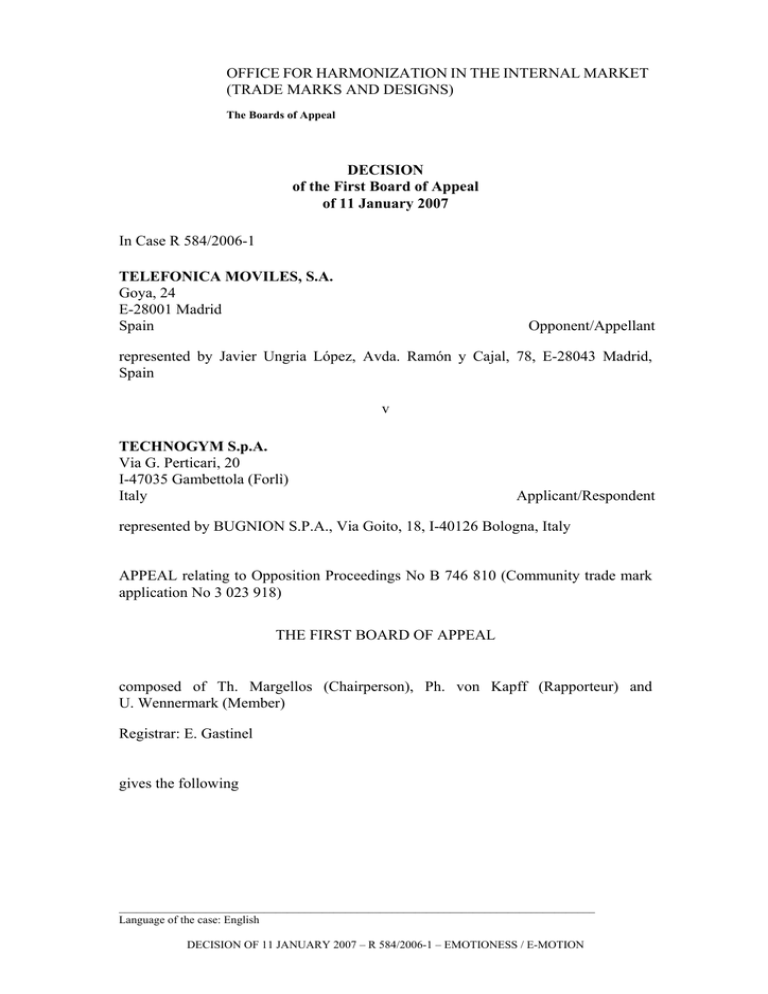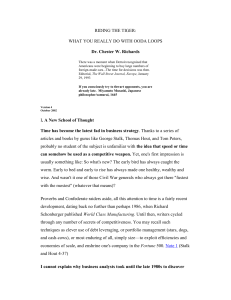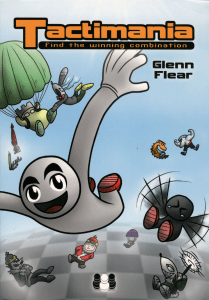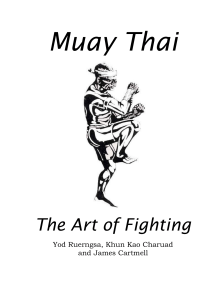TRADE MARKS AND DESIGNS
Anuncio

OFFICE FOR HARMONIZATION IN THE INTERNAL MARKET (TRADE MARKS AND DESIGNS) The Boards of Appeal DECISION of the First Board of Appeal of 11 January 2007 In Case R 584/2006-1 TELEFONICA MOVILES, S.A. Goya, 24 E-28001 Madrid Spain Opponent/Appellant represented by Javier Ungria López, Avda. Ramón y Cajal, 78, E-28043 Madrid, Spain v TECHNOGYM S.p.A. Via G. Perticari, 20 I-47035 Gambettola (Forlì) Italy Applicant/Respondent represented by BUGNION S.P.A., Via Goito, 18, I-40126 Bologna, Italy APPEAL relating to Opposition Proceedings No B 746 810 (Community trade mark application No 3 023 918) THE FIRST BOARD OF APPEAL composed of Th. Margellos (Chairperson), Ph. von Kapff (Rapporteur) and U. Wennermark (Member) Registrar: E. Gastinel gives the following __________________________________________________________________________________ Language of the case: English DECISION OF 11 JANUARY 2007 – R 584/2006-1 – EMOTIONESS / E-MOTION 2 Decision Summary of the facts 1 By an application which was granted a filing date of 27 January 2003, the applicant sought to register the word mark EMOTIONESS for a number of goods in Classes 3, 5, 9, 10, 16, 25, 28, 35, 38, 41, 42. 2 The application was published in Community Trade Marks Bulletin on 21 June 2004. 3 On 21 September 2004, the opponent, acting under the company name ‘TELEFONICA MOVILES, S.A.’, filed an opposition against the registration of the published trade mark application for all the above goods. The opposition was based on: A. the word mark E-MOCION registered as a Community trade mark under No 1 673 029 for goods and services in Classes 16, 35, 41 and 42. B. the figurative mark registered as a Community trade mark under No 001672971 for goods and services in Classes 9, 16, 35, 38, 41 and 42. C. the figurative mark, claiming the colours blue, green, white, orange, dark orange, DECISION OF 11 JANUARY 2007 – R 584/2006-1 – EMOTIONESS / E-MOTION 3 registered as a Community trade mark under the number No 1 672 773 for goods and services in Classes 9, 16, 35, 38, 41 and 42. 4 The opponent founded its opposition on a likelihood of confusion pursuant to Article 8(1)(b) of Council Regulation (EC) No 40/94 of 20 December 1993 on the Community trade mark (‘CTMR’) (OJ EC 1994 No L 11, p. 1; OJ OHIM 1/95, p. 52) due to the identity and/or similarity of the concerned marks and goods. 5 Together with the notice of opposition the opponent submitted extracts from the official CTM-ONLINE database relating to the earlier CTM registrations 1 672 773, 1 672 971 and 1 673 029. These extracts, however, were in the name of TELEFONICA MOVILES, S.A.U.. 6 On 1 December 2004 the Opposition Division informed the opponent that it had until 13 April 2005 to submit any further material it felt necessary to support its opposition. This period was subsequently extended until 13 June 2005. Attached to the notification of 1 December 2004, the Opposition Division, sent an information sheet on evidence stating the particulars to be proved: “8(1) CTMR : Earlier registration or application (other than CTM): all the formal and substantive particulars must be shown, namely (a) the issuing authority (b) the filing and/or registration number(s) (c) the territorial extent (for international registrations) (d) the filing, priority & registration dates (e) a representation of the sign as filed or registered (f) the goods/services covered (g) the expiry date of the registration (h) the opponent’s ownership, as well as (i) any other inscription affecting the legal status or the scope of protection of the mark (disclaimers, limitations, renewals, transfers, pending actions etc.).” 7 The opponent did not file any observations in reply. 8 By decision of 28 February 2006 ruling on opposition No B 746 810 (hereinafter ‘the contested decision’), the Opposition Division rejected the opposition on the following grounds: • Together with the notice of opposition the opponent submitted extracts from the official CTM -ONLINE database relating to the earlier CTM registrations 1 672 773, 1 672 971 and 1 673 029. These extracts, however, were not in the name of the opponent, TELEFONICA MOVILES, S.A., but rather in the name of TELEFONICA MOVILES, S.A.U.. The Office points out that TELEFONICA MOVILES, S.A.U. is the current owner of these registrations. Therefore, according to Rule 19(2) IR the opponent failed to file proof of its entitlement to file an opposition based on these earlier registrations. As no evidence was provided to substantiate the ownership of these earlier rights the DECISION OF 11 JANUARY 2007 – R 584/2006-1 – EMOTIONESS / E-MOTION 4 opponent did not prove within the deadline given that it is entitled, in accordance with the provisions of Article 42(1)(a)CTMR, to enforce earlier CTM registrations No 1 672 773, 1 672 971 and 1 673 029 cited as the basis of the opposition. Thus, the opposition must be rejected in accordance with Rule 20(1). 9 On 26 April 2006, the opponent filed an appeal against the entirety of the contested decision. Submissions and arguments of the parties 10 The arguments raised by the appellant in the statement of grounds may be summarised as follows: • Both names refer to the same company according to Spanish law. The opponent’s registered company name is TELEFONICA MOVILES, S.A.. The opponent is the owner of the three earlier trade marks. 11 No observations were sent by the applicant. Reasons 12 The appeal complies with Articles 57, 58 and 59 CTMR and Rules 48 to 49 of Commission Regulation (EC) No 2868/95 of 13 December 1995 implementing Council Regulation (EC) No 40/94 on the Community trade mark, hereinafter ‘CTMIR’ (OJ EC 1995 No L 303, p. 1; OJ OHIM 2-3/95, p. 258). It is therefore admissible. 13 The appeal is also well founded and the contested decision is annulled. It is clear that the opponent is the proprietor of the earlier trade marks. 14 The Opposition Division was correct to state that according to Article 42(1)(a) CTMR, the proprietor of earlier trade marks referred to in Article 8(2) CTMR may file an opposition to the registration of a Community trade mark application. According to Rule 15(2)(b) CTMIR, the notice of opposition shall contain a clear identification of the earlier mark on which the opposition is based. 15 When, however, the opposition is based on a Community trade mark, the opponent only needs to indicate that it is a Community trade mark and the corresponding registration number. According to Rule 15(2)(h) CTMIR, the notice of opposition shall further contain the name and address of the opposing party in accordance with Rule 1(1)(b) CTMIR. Contrary to what the Opposition Division appears to have assumed in the contested decision, no further proof of ownership of the earlier Community trade marks under Rule 19(1)(2)(a) CTMR, is necessary. DECISION OF 11 JANUARY 2007 – R 584/2006-1 – EMOTIONESS / E-MOTION 5 16 The opponent filed its opposition in the name of ‘Telefónica Móviles S.A.’. The company is the same as the one that filed the earlier Community trade marks at issue and which is named there as ‘Telefónica Móviles S.A.U.’. 17 It is mandatory for a Spanish sociedad anónima (public limited company) to indicate ‘sociedad anónima’ or its abbreviation ‘S.A.’ in the name, as foreseen in Article 2 of Spanish Law on Public Limited Companies1. No other abbreviation other than ‘S.A.’ is admissible. This obligation does not change, even when a ‘sociedad anónima’ has a single shareholder (sociedad anónima unipersonal). 18 Equally, when registering a Spanish sociedad anónima into the company’s register, the type of company must, in accordance with Article 403 of the Law on the Commercial Register2, be indicated without any additional reference to the unipersonal character. 19 Only, with respect to its documentation, correspondence, commercial orders and invoices, along with all announcements, does a unipersonal limited company have to publish according to legal or statutory provisions, and in such a case the company must refer to the fact that it has only one shareholder, as provided for in the combined provisions of Article 311 Spanish Law on Public Limited Companies3 and Article 126 Spanish Law on Limited Companies4. 20 The unipersonal company may indicate its unipersonal character to the public when acting in the course of trade or industry in particular by either adding the 1 ‘Artículo 2 Ley de sociedades anónimas – Denominación 1. En la denominación de la compañía deberá figurar necesariamente la indicación “sociedad anónima” o su abreviación. …’ 2 ‘Artículo 403 Reglamento del Registro Mercantil – Indicación de la forma social 1. En la denominación social deberá figurar la indicación de la forma social de que se trate o su abreviatura. En el caso de que figure la abreviatura, se incluirá esta al final de la denominación. 2. En las denominaciones de las sociedades inscribibles, solo podrán utilizarse las siguientes abreviaturas: 1ª S.A., para la sociedad anónima. …’ 3 ‘Articulo 311 Ley de sociedades anónimas – Sociedad anónima unipersonal Será de aplicación a la sociedad anónima unipersonal lo dispuesto en el capitulo XI de la Ley de Sociedades de Responsabilidad Limitada.’ 4 ‘Capitulo XI Ley de sociedades de Responsabilidad Limitada - Sociedad Unipersonal de responsabilidad Limitada Artículo 126 – Publicidad de la unipersonalidad 1. La constitución de una sociedad unipersonal de responsabilidad limitada, la declaración de tal situación como consecuencia de haber pasado un único socio a ser propietario de todas las participaciones sociales, la perdida de tal situación o el cambio del socio único como consecuencia de haberse transmitido alguna o todas las participaciones, se harán constar en escritura publica que se inscribirá en el Registro Mercantil. En la inscripción se expresara necesariamente la identidad del socio único. 2. En tanto subsista la situación de unipersonalidad, la sociedad hará constar expresamente su condición de unipersonal en toda su documentación, correspondencia, notas de pedido y facturas, así como en todos los anuncios que haya de publicar por disposición legal o estatutaria.’ DECISION OF 11 JANUARY 2007 – R 584/2006-1 – EMOTIONESS / E-MOTION 6 word ‘unipersonal’ or by using the abbreviation ‘U’, such as in ‘S.A.U.’. However, it remains that ‘unipersonal’ is not part of the company name. It will, therefore, not be registered as such and must be dropped in the course of trade once additional shareholders join the company. 21 As the opponent explained, the company had first only one shareholder and added therefore the ‘U’ to its name, when filing the Community trade mark. When, later, more shareholders joined, the ‘U’ was dropped, but without, in effect, changing the name of the company in the Community trade marks register. 22 Furthermore, another aspect should have led the examiner to assume that ‘Telefónica Móviles S.A.’ and ‘Telefónica Móviles S.A.U.’ must refer to the identical company: under Spanish law, identical company names cannot be registered twice for a limited company, as prohibited by Article 2 of the Spanish Law on Public Limited Companies5. 23 The Opposition Division should have known these aspects of Spanish company law (see judgments of the Court of First Instance of 20 April 2005 in Case T318/03 Atomic Austria GmbH v OHIM (‘Atomic Blitz’) [2005] ECR II-1319; and of 6 September 2006 in Case T-6/05 DEF-TEC Defense Technology GmbH v OHIM (‘First Defense Aerosol Pepper Projector’) [2006] ECR publication pending). 24 If it had doubts, the Opposition Division, should have referred to the opponent in accordance with Article 43(1) CTMR, which states that the Opposition Division must refer to the parties as often as necessary. 25 In addition, the Opposition Division did not give the right to be heard, this contrary to Article 73 CTMR, which states that the Office shall base its decision only on reasons or evidence on which the parties concerned have had an opportunity to present their comments. 26 Under these circumstances, rectification under the rules of revision of decisions in inter partes cases in accordance with Rule 60a CTMR would have seemed appropriate. Costs 27 In application of Article 81(2) CTMR, it seems appropriate, that each party bears its own costs in the appeal proceedings. 5 ‘Articulo 2 Ley de sociedades anónimas – denominación 2. No se podrá adoptar una denominación idéntica a la de otra sociedad preexistente.’ DECISION OF 11 JANUARY 2007 – R 584/2006-1 – EMOTIONESS / E-MOTION 7 28 Moreover, not granting the right to be heard, which might have clarified the wrong application of Spanish law, amounts to a substantial procedural violation under Rule 51 CTMIR, and this, therefore justifies the reimbursement of the appeal fee. DECISION OF 11 JANUARY 2007 – R 584/2006-1 – EMOTIONESS / E-MOTION 8 Order On those grounds, THE BOARD hereby: 1. 2. 4. 3. Annuls the contested decision dated 28 February 2006 in opposition case No B 746810. Remits the case to the Opposition Division. Orders the reimbursement of the appeal fee. Orders each party to bear its own costs incurred in the appeal procedure. Th. Margellos Ph. von Kapff U. Wennermark Registrar: E. Gastinel DECISION OF 11 JANUARY 2007 – R 584/2006-1 – EMOTIONESS / E-MOTION



